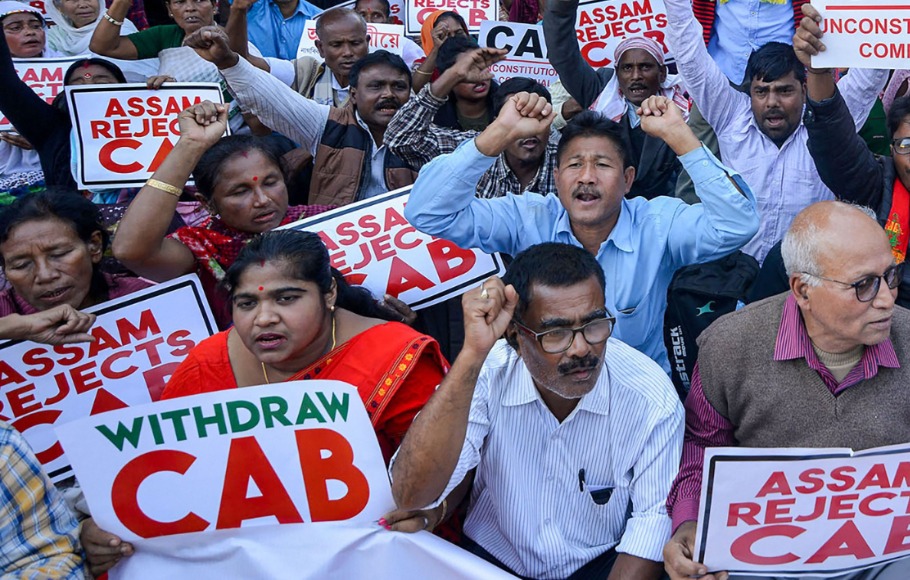
In Assam, songs of Bhupen Hazarika, Zubeen Garg are now protest anthems
Assam has been at the forefront of the anti-Citizenship law protests that now echoes from across the length and breadth of the country. In the northeastern state, thousands have taken to the streets, voicing their opposition to the contentious legislation. And musicians, old and new, have helped the protesters find a new tune.

Assam has been at the forefront of the anti-Citizenship law protests that now echoes from across the length and breadth of the country. In the northeastern state, thousands have taken to the streets, voicing their opposition to the contentious legislation. And musicians, old and new, have helped the protesters find a new tune.
Songs of iconic singer Bhupen Hazarika and newer idol Zubeen Garg have become an anthem for the protesters in Assam. ‘Biswa Bijoyee Naujowan’ and by Hazarika is sung by people during protests against the contentious Citizenship Act, besides ‘Jai Aai Axom, a powerful song of the state that has now become the rallying cry of the movement.
At a tea stall in Chandmari or a paan shop in Ganeshguri in Guwahati, people can be seen listening to Zubeen Garg’s famous songs like ‘Maya’ or ‘Politics Nokoriba Bondhu’ on mobile phones. Garg, 47, who is now one of the most vocal faces of the movement against the new law, says culture is a very integral part of any person’s or community’s identity.

“This movement is also about our Assamese identity, driven by our ancient culture and traditions, clothes, food, language and songs,” Garg told news agency PTI. “Youths and women of Assam are our major strength in this agitation against the CAA. And, together we sing songs during protests, infusing energy into each other.”
While the agitation in Assam against the contentious law seeks its revocation, many protesters said they have joined the movement because of perceived fear of Assamese culture “getting subjugated” in the wake of influx of Bangladeshi immigrants to the state.
“We don’t want to become a cultural or linguistic minority in our own home state. In the past, Bengali language had been imposed on Assamese, and we fear it might happen again in future,” said film-maker Garima Garg. “So, this movement is also driven by an urge to safeguard our cultural legacy. And, I am happy so many youths have joined it.”
Also read | Citizenship Act reopens old wounds of Assamese sub-nationalism
“We are not being anti-Bengali, we have read Rabindranath Tagore and we even have a Rabindra Bhawan in Guwahati. But, we are just worried about our own culture,” she said.
Garima, wife of Zubeen Garg, feels the agitation against the Citizenship Act has brought people of Assam, especially the youth, closer to their culture.
“Assamese have always taken pride in their culture, from literature to cinema, clothes to songs, but perhaps many had taken it for granted. And now with mass protests, that cultural connection is really tugging at their hearts and those who loved Assamese culture, for them the bond has become stronger,” she told PTI.

From Latasil playground to Chandmari grounds, two major centres of protests in Guwahati, a large number of artistes, wearing ‘gamosas’, have joined the movement, singing songs to show dissent.
Besides the Gargs, several other personalities from the music, arts and film fraternity, including actors Barsha Rani Bishaya, Prastuti Parashar and Nishita Goswami, and singers Krishnamoni Chutia, Dikshu and Manas Robin, have vocally supported the movement and taken part in various protests.
‘Jai Aai Axom’ and ‘Biswa Bijoyee Naujowan’ were two of the major songs performed by artistes on stage at these venues and even in marches by Guwahati advocates recently, the lawyers had sung the Bhupen Hazarika classic to register their protest against the citizenship law.
ALso read | Gamosa to Joi Aai Asom, the signs of pride that shaped Assam protests
Chinmoy Deka, 18, a student of B Borooah College in Guwahati, said while the youth of Assam are very much aware of their art, culture and heritage, the movement has “definitely augmented” the knowledge about the state’s cultural legacy and iconic personalities.
In Digholi Pukhuri, near Latasil playground, where protesters are detained, huge, iconic statues of legendary singer Hazarika, and RG Baruah, hailed as the “architect of modern Assam”, dot the lake park.
Ask any protester, young or old, if they know iconic exponents like Baruah, also the founder of first English daily of the Northeast region — ‘The Assam Tribune’ — or pioneering film-maker of Assam Jyoti Prasad Agarwala, poet Lakshminath Bezbaroa and playwright Phani Sarma, and he or she nods head in the affirmative.
The Ganeshguri flyover, which saw intense protests on December 11-12 with rings of fire lit up across its stretch by agitators, is incidentally named after legendary Assamese litterateur ‘Kalaguru’ Bishnu Prasad Rabha.
Also read | AASU dares Modi to inaugurate ‘Khelo India’ games in Guwahati
Neighbouring the Digholi Pukhuri is the district library where statues of Rabha, Agarwala and Sarma majestically stand together on its premises, with its wall carrying the old slogan ‘No CAB’ scrawled on it when the legislation was being debated in Parliament.
Ganesh Das, a Guwahati local said, so much of culture of Assam gets displayed during the protests, so people either learn about it or cultural roots get reinforced in their consciousness.
And, indeed the level of consciousness for art and culture has increased in the last few months, says Nilakshi Das, 17, a Class 12 student in Guwahati, as she points to a sitting statue of Assamese folk singer Pratima Barua Pandey, captured in her singing posture, near the Chandmari grounds.
“We have been taught so much about the legendary Assamese personalities in schools. But now when we see some statue of a person in the city, we stop by to admire it and read intently the writings inscribed on its plaques. The Assamese pride in us has got pronounced,” Das said.
(With inputs from agencies)


